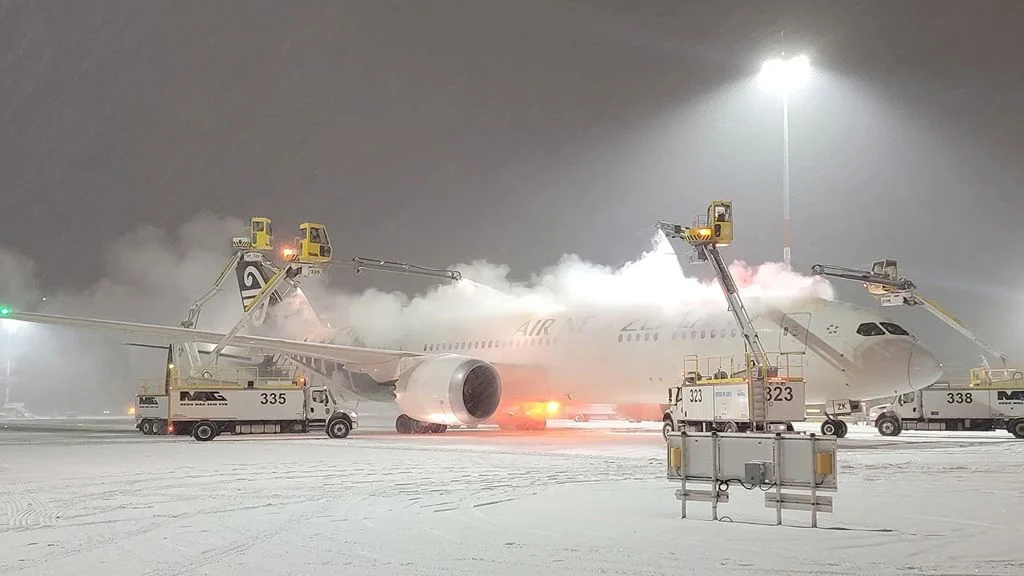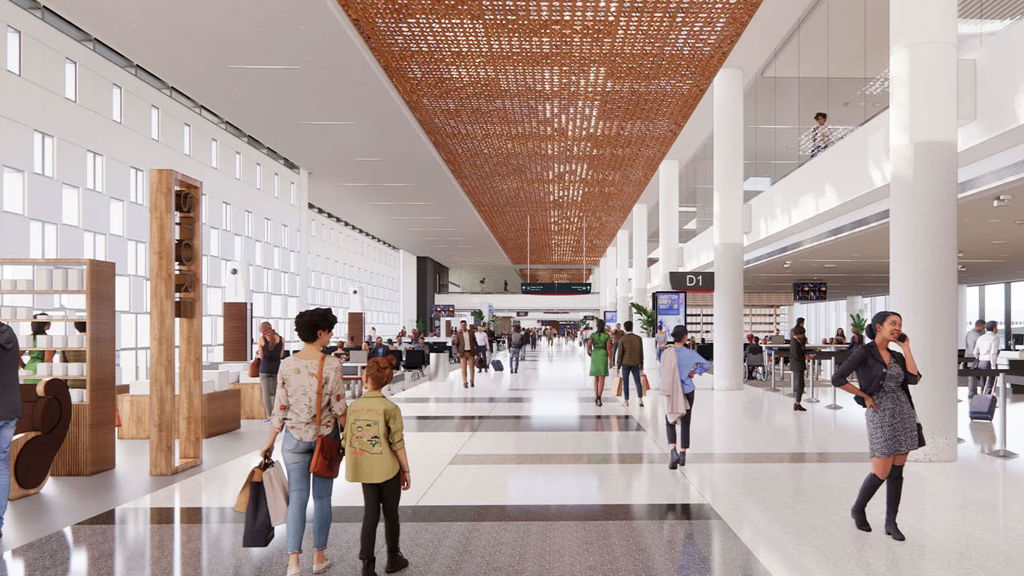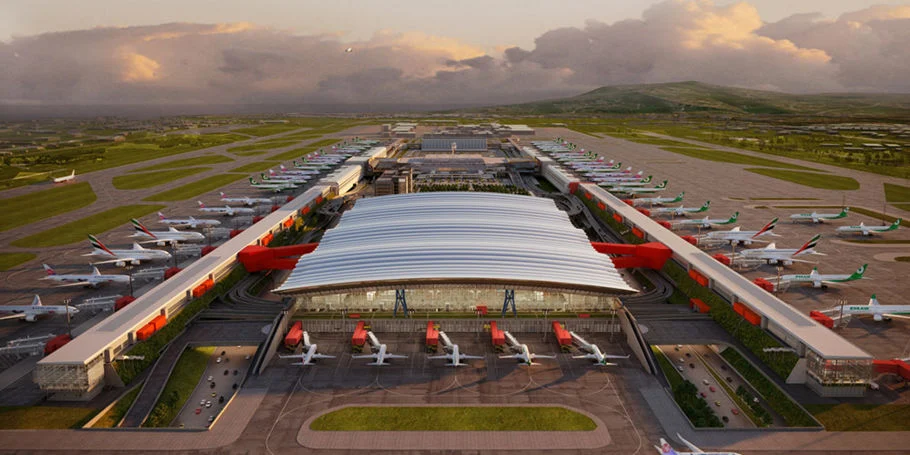Ireland’s tallest occupied structure, standing at 87.7 metres, enhances airport operations
IAA Visual Control Tower, Dublin Airport

What we delivered
-
Our engineers and consultants worked from concept to construction on this 87.7m high tower – Ireland’s tallest occupied structure
-
The 35-tonne tuned mass dampers effectively reduce wind-induced vibrations, enhancing stability and creating a comfortable working environment for air traffic controllers
-
The bespoke façade design enables 360-degree views, facilitating seamless aircraft take-offs and landings with maximum safety and efficiency
Get in touch with our team
Dublin Airport, one of Europe’s fastest-growing connectivity hubs, continues to prepare for the future with the construction of a new visual control tower that, together with a new runway, helps with airspace management and traffic flow.
Visual air traffic control towers are an airport’s central processing hub, a piece of critical safety infrastructure to ensure that aircrafts move seamlessly through airports.
Arup carried out the civil, structural, mechanical and electrical engineering; and also provided environmental, lighting and façade consultancy services, bringing the project from concept to construction stage. We designed the tower as a slim, elegant structure, offering clear sight lines of both runways.
At 87.7m high, the visual control tower is the country’s tallest occupied structure and is a commanding new addition to the city’s skyline.
Designing for the needs of air traffic controllers
The height of the new tower ensures appropriate visibility of runways, thresholds, manoeuvring areas and stands. The needs of the air traffic controllers were a key consideration during the design, with a view to aiding concentration by ensuring maximum comfort and reducing potential distractions.
Given the height of the tower, minimising wind-induced vibrations was a crucial aspect of the design. Arup’s structural engineers, in conjunction with RWDI, carried out a series of wind tunnel tests to determine the specifications for the two tuned mass dampers (TMD). A TMD is a large mass of steel inside the tower designed to absorb vibration energy. It is tuned to vibrate at the same frequency as the structure, reducing the sway of the tower and creating a positive work environment for air traffic controllers.
Bespoke façade design enables 360-degree views of the airfield
The façade was designed to ensure that air traffic controllers have optimum views to enable efficient take-offs and landings. The size of the glass panels was maximised. A bespoke conical shaped unitised curtain wall façade was designed, delivering the architectural intent for the control room.
Insulating glass was used for the visual control room and conical façade below, with solar radiation minimised through the use of a high-performance solar control coating. Appropriate interlayers in the glass minimise internal reflection while also improving acoustic performance.

The façade design ensures clear sight lines of both runways. Photo credit: Paul Tierney
Innovative lighting design creates a welcoming beacon
The tower lighting gives the control tower a distinct visual identity, with nine bands of multi-coloured LED strip lights allowing a range of colours and visuals to be programmed to show on the façade by night. The lighting design for the curved façade ensures a consistent appearance for the tower at night.
Future maintenance was a key consideration, with the luminaires housed within the interior of the façade and special care applied to develop the access strategy, incorporating a building maintenance unit (BMU) for future glass replacement and façade maintenance.

The lighting design gives the control tower a distinct visual identity. Photo credit: Paul Tierney
Designing for constructability
We designed the tower to take into consideration the necessary techniques when constructing high-rise buildings. Slipform concrete core construction was used for the tower, whereby the concrete is poured in a continuously moving form 24/7. Slip forming is not a common method of construction in Ireland but is incredibly beneficial for tall buildings.
The tower’s footprint includes a fluvio-glacial channel and sits within a zone of variable underlying rock. To mitigate risks from local ground conditions, Arup provided full-time supervision, giving visual confirmation of the rock socket and carrying out verticality and integrity tests.
Resilient design safeguards air navigation services
Resilience, safety and operational comfort for air traffic controllers were key when designing the tower. Due to the vital nature of air traffic controllers’ work, it was important to ensure that all building services and safety systems are resilient. Critical equipment has uninterruptible power supplies (UPS), with duplicate supplies and routes incorporated on many primary and secondary mechanical and electrical systems, ensuring that they will continue to operate when the plant is under maintenance or should power failures occur.
The design of the landscaping adds further resilience, protecting the plant areas at the base of the tower in the event of heavy rain. Floodwater is diverted away from the tower and the adjoining pavilion building, protecting the critical infrastructure in basement areas.

The IAA Visual Control Tower at Dublin Airport helps with airspace management and traffic flow. At 87.7m high, the visual control tower is the country’s tallest occupied structure. Photo credit: Paul Tierney
BAM Building Ltd. / Bitschnau GMBH / Gabriel O’Brien Crane Hire Ltd. / HA O’Neil / Jones Engineering Group / Linesight / Mercury Engineering / Metal Yapi / Michael Slattery & Associates / ProCert / Quinn Piling / RWDI / Scott Tallon Walker Architects / Taranto Ltd / Techrete Ireland Limited / Vicoda Group
Projects
Explore more aviation projects:

Transforming the travel experience at Zayed International Airport
Zayed International Airport Terminal A, United Arab Emirates

Crafting a New York–inspired atmosphere for passengers traveling through JFK’s global gateway to the world
JFK New Terminal One Art, Branding, and Digital Experience Program, United States of America

Helping Vancouver International Airport to prepare for unexpected weather
Vancouver International Airport After Action Review, Canada

Seamless redevelopment and renovation at George Bush Intercontinental Airport
IAH Terminal Redevelopment Program, United States of America
Get in touch with us
If you'd like to speak to one of our aviation experts about any of the issues raised on this page or a potential collaboration then please get in touch by completing the form.

